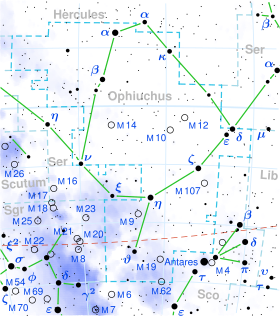| Observation data Epoch J2000 Equinox J2000 | |
|---|---|
| Constellation | Ophiuchus [1] |
| Right ascension | 17h 27m 21.27571s [2] |
| Declination | −29° 52′ 01.3262″ [2] |
| Apparent magnitude (V) | 4.28 [1] |
| Characteristics | |
| Spectral type | F5III-IV [3] |
| U−B color index | +0.11 [4] |
| B−V color index | +0.40 [4] |
| Astrometry | |
| Radial velocity (Rv) | +38.00 [5] km/s |
| Proper motion (μ) | RA: +17.08 [2] mas/yr Dec.: −138.02 [2] mas/yr |
| Parallax (π) | 29.23±0.20 mas [2] |
| Distance | 111.6 ± 0.8 ly (34.2 ± 0.2 pc) |
| Absolute magnitude (MV) | 1.61 [1] |
| Details | |
| Mass | 1.71 [6] M☉ |
| Radius | 3.2 [6] R☉ |
| Luminosity | 19.07 [1] L☉ |
| Surface gravity (log g) | 3.67 [6] cgs |
| Temperature | 6,750 [7] K |
| Metallicity [Fe/H] | +0.10 [7] dex |
| Rotational velocity (v sin i) | 65.4 [8] km/s |
| Age | 1.24±0.18 [7] Gyr |
| Other designations | |
| d Oph, 45 Oph, CD−29°13557, FK5 646, GC 23627, HD 157919, HIP 85423, HR 6492, SAO 185412 [9] | |
| Database references | |
| SIMBAD | data |
45 Ophiuchi is a single [10] star in the equatorial constellation of Ophiuchus, along the southern border with Scorpius. It has the Bayer designation d Ophiuchi, while 45 Ophiuchi is the Flamsteed designation. In the past it had the designation Theta Telescopii. [11] This object is visible to the naked eye as a faint, yellow-white hued star with an apparent visual magnitude of 4.28. [1] It is located approximately 111.6 light years away from the Sun based on parallax. [2] The star is drifting further from the Earth with a heliocentric radial velocity of +38 km/s. [5]
This object has a stellar classification of F5III-IV, [3] matching an F-type star with a luminosity class displaying mixed traits of a subgiant and a giant star. It is 1.2 [7] billion years old with 1.7 [6] times the mass of the Sun and 3.2 [6] times the Sun's radius. The star is radiating 19 [1] times the luminosity of the Sun from its photosphere at an effective temperature of 6,750 K. [7] It is spinning with a projected rotational velocity of 65 km/s. [8]
